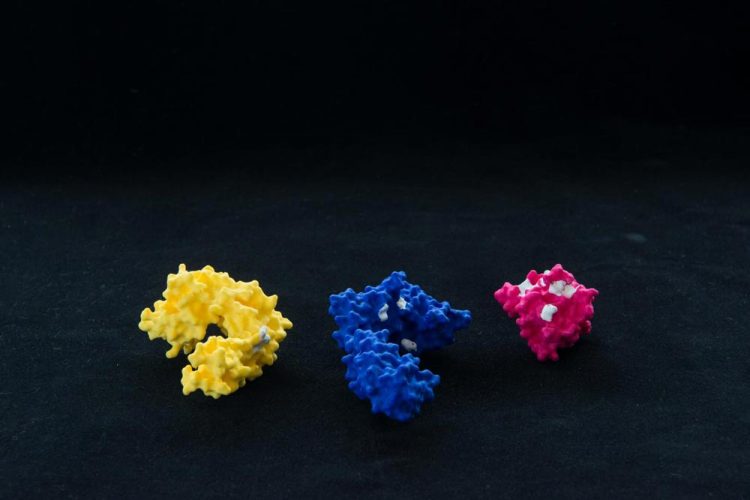Mason scientists invent new technology to streamline drug discovery

These 3-D models of a receptor, co-receptor, and ligand demonstrate how the protein painting technology works. Bound proteins in their native form are coated with small molecule dyes. The regions which aren't painted when the proteins are bound, designated white, can be detected by mass spectrometry and inform rational drug development. Photo by Evan Cantwell
According to Amanda Haymond, lead author on the study and researcher in the Center for Applied Proteomics and Molecular Medicine and Institute for Biohealth Innovation, the discovery was made possible by an in-house developed protein-painting technology, funded by the National Cancer Institute's Innovative Molecular Analysis Technology (IMAT) program.
“The goal of IMAT is to support the creation of novel technologies that enable scientists to make transformative discoveries in cancer research that were not possible before,” Tony Dickherber, director of the IMAT program, said.
The protein painting technology, developed under National Institutes of Health funding, is indeed transformative. The process starts with two or more proteins that when bound together, drive disease. The scientists use small molecule dyes to paint the bound proteins, and then a chemical reaction known as denaturation chops them up. The final step is when scientists use a mass spectrometer to identify the unpainted regions, which is where the proteins touch.
Current technologies in early phase drug discovery, such as crystallography, are often complicated, costly, and time-consuming. The protein painting technology specifically identifies protein-protein touchpoints, highlighting an ideal location and recipe to follow for drug development. The recipe, along with the fact that the technology allows for rapid performance testing of the drug, means that results can be produced in several days, rather than years.
To build on this success, the Mason team needed to push more boundaries. In the new article, the team describes how they enhanced their technology, reporting the development and optimization of a novel protein dye that has been successfully tested on clinically relevant protein complexes, PD-1 and PD-L1. The publication also unveils new findings that chemically decipher the way that dyes interact with proteins, which has been a mystery to scientist for decades.
“The secret to using the protein-painting technique is having the perfect dye molecule with just the right structure to bind tightly onto proteins,” Haymond said.
Monet Pharmaceuticals, a newly formed pharmaceutical company based in Prince William County, Virginia, has partnered with the Mason team to exclusively license patents owned by the university broadly covering the protein-painting technology.
“We have many talented faculty at Mason who create groundbreaking technologies, but it takes partnerships to maximize impact. In this case, the impact is accelerating the drug discovery paradigm,” Lance Liotta, co-director of the Center for Applied Proteomics and Molecular Medicine, said.
While the impressive technology has the potential to transform the drug discovery process, it is grounded by humble beginnings.
“It started with a simple idea that we were able to test in the lab. This is a prime example of why we should always ignore the impeding thoughts that someone must have thought of this already, or that an experiment would never work. Some of the simplest ideas can lead to the biggest discoveries,” Haymond said.
###
About George Mason University
George Mason University is Virginia's largest public research university. Located near Washington, D.C., Mason enrolls 37,000 students from 130 countries and all 50 states. Mason has grown rapidly over the last half-century and is recognized for its innovation and entrepreneurship, remarkable diversity, and commitment to accessibility. Learn more at http://www.
About the Institute for Biohealth Innovation
The Institute for Biohealth Innovation (IBI) promotes and supports biohealth-related research activities of faculty, staff, and students at George Mason University. The IBI connects Mason researchers in biohealth with potential collaborators, both within the university and externally, to advance human health research. Learn more and hear more from our researchers in a newly released video at https:/
About Monet Pharmaceuticals
Monet Pharmaceuticals is a newly formed pharmaceutical company based in Prince William County, Virginia that has exclusively licensed patents owned by the university covering the protein-painting technology. Monet is collaborating with George Mason University researchers on high value therapeutic targets utilizing the protein-painting technology. Together, they are discovering and developing novel therapeutics.
Media Contact
More Information:
http://dx.doi.org/10.1074/jbc.RA118.007310All latest news from the category: Life Sciences and Chemistry
Articles and reports from the Life Sciences and chemistry area deal with applied and basic research into modern biology, chemistry and human medicine.
Valuable information can be found on a range of life sciences fields including bacteriology, biochemistry, bionics, bioinformatics, biophysics, biotechnology, genetics, geobotany, human biology, marine biology, microbiology, molecular biology, cellular biology, zoology, bioinorganic chemistry, microchemistry and environmental chemistry.
Newest articles

A ‘language’ for ML models to predict nanopore properties
A large number of 2D materials like graphene can have nanopores – small holes formed by missing atoms through which foreign substances can pass. The properties of these nanopores dictate many…

Clinically validated, wearable ultrasound patch
… for continuous blood pressure monitoring. A team of researchers at the University of California San Diego has developed a new and improved wearable ultrasound patch for continuous and noninvasive…

A new puzzle piece for string theory research
Dr. Ksenia Fedosova from the Cluster of Excellence Mathematics Münster, along with an international research team, has proven a conjecture in string theory that physicists had proposed regarding certain equations….



